Previous Chapter 6 - The First Officer Commanding E Company Next Chapter 8 - E Company - The Early Years - The 70s
Chapter
7 – Establishing E Company 5th (Co Londonderry)
Battalion, The Ulster Defence Regiment
Prelude
to Terrorism
There
were two phases of civil dissent preceding the 1970–2005
Loyalist and Republican terrorist campaigns. The first phase
involved a short-lived civil rights campaign. This was followed
by a series of left-wing confrontations and then the terrorist
campaign started.
The first phase can be traced back to 1962, just after the
failure of the last IRA murder and sabotage campaign known as
Operation Harvest (1956–1962). The IRA leadership reappraised
their strategy and moved from murder and sabotage campaigns to
political action. This led to elements of the IRA attending a
planning conference in August 1966, which then led to the
formation of the Northern Ireland Civil Rights Association (NICRA)
on 9 Apri1967.
Those attending that first conference included Cathal
Goulding, who was the Chief of Staff of the Irish Republican Army
(IRA), (Coogan, p 482), several protest group leaders and various
politicians. The IRA as an organisation was dormant at this time
but there were Republicans involved who believed that the
non-sectarian civil rights movement could be used to ‘subvert
Unionist power in Northern Ireland’ (Smith, p81).
In order to influence civil and human rights reforms in
Northern Ireland the NICRA adopted the non-confrontational
methods used by Dr Martin Luther King Jr in the USA during the
early 60s. Both Protestants and to a greater degree Roman
Catholics in Northern Ireland had genuine grievances and both
communities stood to benefit from any such reforms.
The first protest march in August 1968 was a peaceful
event. It contained a good cross section of Northern society with
university students, Roman Catholics, Protestants, left-wing
militants and IRA activists all enjoying the day out. By August
1968, the peaceful protests and the singing of ‘We Shall
Overcome’ were antagonizing more and more Protestants. Many
viewed the song as threatening rather than a Roman Catholic
desire to overcome institutionalised discrimination. Paisleyite
and Unionist groups started to organise counter demonstrations.
This in turn led to the banning of many protest marches and an
increase in sectarian conflict.
By October 1968 the second phase of the descent into
terrorism started. The objectives, composition and the approach
of the NICRA protests started to change. The non-sectarian ethos
disappeared and the protests became more provocative. This new
radical approach appeared to be more influenced by the French
student riots of the 60s than the Dr Martin Luther King Jr
protests. Within the next two years many of the reforms such as
the disarming of the RUC were lost when sectarian violence
undermined the civil rights campaign to a degree where civil
rights and Irish nationalism united.
The civil rights demands then became nothing more than a
smokescreen behind which left-wing activists and Republicans
pursued the destruction of the state of Northern Ireland through
confrontation. This confrontational approach would evolve over
the next thirty years into the Adams Republican ‘cutting
edge’ philosophy (O’Doherty, p98). Confrontations and
terrorist attacks were used to promote Republican propaganda and
to remind the world ‘that there is an unresolved problem to be
dealt with’ in Ireland.
During these early protests the policing problems were
compounded by Unionist politicians who ignored the opinions of
senior RUC officers (Doherty, p76) Political interference
constantly forced the RUC, the Ulster Special Constabulary and
the army on some occasions to confront the sustained and
coordinated civil disobedience campaign with inappropriate and
repressive tactics. This destructive Unionist interference
continued until Direct Rule was implemented in 1972.
Then on New Years Day 1969, the left wing students group
called People’s Democracy (PD) organized their infamous march
from Belfast to Londonderry via Burntollet Bridge. This march
proved to be as contentious as the
‘Love Ulster’ parade planned for Dublin in 2006. The
belligerence of the ‘marchers’ was apparent from the
beginning, as many were later found guilty of assault when they
kicked their RUC escort party to the ground and trespassed onto
the Overend Farm in Bellaghy. The RUC are often accused of
failing to protect the ‘marchers’ at Burntollet but the
Bellaghy assault proved that they were under strength and
incapable of dealing with serious incidents.
As expected the 1969 coat trailing affront through many
Protestant areas with tricolours flying created many bloody
confrontations. During the follow-up riots in Londonderry city
several phone calls went out from the left wing agitators
requesting supporters to start similar confrontations throughout
the province. (Wallace, 1969). This tactic was designed to
stretch the Royal Ulster Constabulary (RUC) beyond their capacity
to cope. The tactic worked and in August 1969 troops were sent to
Northern Ireland to support the exhausted RUC. The stage was now
set for the third phase, the 1970–2005 terrorist campaign.
The Provisional IRA formally established itself on 11
January 1970 (Smith, p83). This was followed in July the same
year by the inaugural meeting of the Woodvale Defence Association
(Wood, p1). Many other Loyalist organisations went on to raise
similar defence units throughout Northern Ireland.
The murder of Northern Ireland citizens by these self
appointed guardians escalated in 1971 and by the year 2001 the
Republican terrorists had murdered 863 Protestants and 408 Roman
Catholics. The Loyalist terrorists murdered 197 Protestants and
704 Roman Catholics (wesleyjohnston.com. 2007). Compared to the
Republican terrorists, the Loyalist terrorists had a relatively
minor role in the murdering of the real guardians of the Northern
Ireland community. To their tally they added the lives of three
UDR soldiers as well as the first and the last policemen to be
killed in the current murder campaign, Constables Arbuckle and
O’Reilly.
Perfidy
The
major deceit exercised by the Republican and Loyalist terrorists
was that of perfidy. That act is defined as wrongful deception or
as the Concise Oxford Dictionary defines it, a deliberate
“breach of faith, treachery”. For all the security forces of
Northern Ireland, perfidy was the major problem. Under Article 37
of the Geneva Convention the act of feigning civilian,
non-combatant status is prohibited.
The ‘Heroes of Ulster’ and ‘Irish Freedom
Fighters’ declared war and always broke the Geneva Convention
by not dressing in the soldiers uniform. Take the typical example
of the midnight murders of Constables Armstrong and McLean on 11th
April 1987 in Portrush. On that date two Republican terrorists
exercised their murderous skills on the RUC for the 240th
time by firing handguns into the backs of the Constables heads.
All the terrorists fought a dirty war that did not require
direct confrontation or holding the ground for extended periods.
The attacks made on E Company in County Londonderry included the
murder of off duty soldiers in front of their families that
sometimes included the murder of their children, Loyalist
infiltration of base locations, the use of car bombs, roadside
and culvert bombs as well as ‘shoot and scoot’ attacks
against the back of vehicle patrols and foot patrols.
Despite the blatant disregard for international rules of
warfare the Republican and Loyalist terrorists caught and
convicted were always claiming that they were not ordinary
criminals but political prisoners or even prisoners of war.
Recruiting
for the Ulster Defence Regiment
In
November 1969, one month after Major George Lapsley had retired
from the Coleraine Battery (Territorial Army) as Battery
Commander an army officer friend from England wrote to him asking
him to join a new army unit being formed in Northern Ireland to
replace the B Specials. It was to be called the Ulster Defence
Regiment (UDR).
George travelled over 900 miles within the next four
months recruiting all over the Province. On one occasion he swore
in a group of volunteers from the Bogside, all Roman Catholics.
Let there be no doubt that even in those dark times there were
many brave people in Republican and Loyalist terrorist controlled
areas prepared to serve their community until they were either
murdered or intimidated out. Take for example the Royal
Enniskilling Fusilier veteran Bobby Boyd. He originally came from
the Creggan and joined the Regiment in those early days. He was
still serving in 5 UDR when Republican gunmen murdered him at his
front door in 1985.
The
Role of the Ulster Defence Regiment
On
the last day of March 1970 the B Specials were stood down and
replaced by the Ulster Defence Regiment. The mendacious tactics
used by nationalist politicians to denigrate the B Specials were
then applied relentlessly on the UDR for the next three decades.
The UDR was known as the largest infantry regiment in the
British Army but it also met all the criteria of a militia. It
was a locally raised unit of volunteers who were tasked to defend
their immediate area and population from internal dissent. It
contained part-time, full-time, male and female volunteers who
resolutely faced terrorism for the benefit of the whole community
of Northern Ireland for the next three decades.
The
initial role of the Regiment was defined in the Battalion
Standing Operational Procedures (SOPs) as, “to support the
Regular Forces in Northern Ireland, should circumstances so
require, in protecting The Border and The State against armed
attack and sabotage”.
The method of fulfilling that role was always
restricted to:
-
Guard duties at key points and installations.
-
Foot, airborne, sea borne and vehicle patrols and search operations.
-
Establishing checkpoints and roadblocks.
Regimental
Structure
Just
like the Militias raised one hundred years before, each Battalion
of the UDR was responsible for a specific area of the Province
with at least one Battalion in each county. The Battalion was
sub-divided into a Battalion Headquarters base and a number of
Companies of 100 men. Each were spread throughout the Battalion
area with their own base locations.
For
the first year of the establishment Lieutenant Colonel Davidson,
an ex-B Specials veteran, commanded 5 UDR.
After that, the command structure of 5 UDR was always
similar to that used in many Colonial defence forces. Posting a
locally born officer to a role senior to that of Company
Commander did not happen too often. Some talented officers did
receive figurehead postings as Colonels or else were given Staff
Officers jobs at Regimental Headquarters or Brigade HQ for a few
years before retiring.
With
rare exceptions, the Battalion was always under the Command of a
Regular Army Commanding Officer (CO). The Battalion
Second-In-Command was usually the most senior part-time officer
and this prevailed until 1991 when the post was designated to a
Regular officer, usually the Training Major. The Quartermasters
Department were normally under the command of a Regular Army
Officer. The Senior Non Commissioned Officer (SNCO) posts of
Communications, Chief Clerk, Intelligence Cell, Armourer and the
Regimental Sergeant Major
(RSM) were always filled by the Regular Army personnel on a
two-year posting.
“This
was always a prime area for successful working relationships or
otherwise depending on how Officers and SNCOs got on with the
various Commanding Officers and other ‘blow ins’ and vice
versa.
Usually we were fortunate to have career minded and highly
motivated Commanding Officers, Training Majors (TISOs),
Quartermasters (QMs) and RSMs over the years who introduced new
and better operational procedures and higher training standards
while there were a few who managed to make little impact on our
war with the terrorists.
Some of the Commanding Officers tried to ‘reinvent the
wheel’ and there were times when the Company commanders and the
Battalion Second-in-Command had to use their influence to ensure
‘new’ tactics worked. Lt. Cpl. Hugh Tarver was one of the few
Commanding Officers who went out on patrol with the part-time
soldiers at night. He usually sat in the back of a Landrover and
joined in any task allocated by the Patrol Commander. There were
many occasions when he stayed out on patrol until 4am and was at
his desk in Battalion Headquarters again at 8.30am” (Hamill,
2007).
Photo 16 Lt Col Hugh Tarver
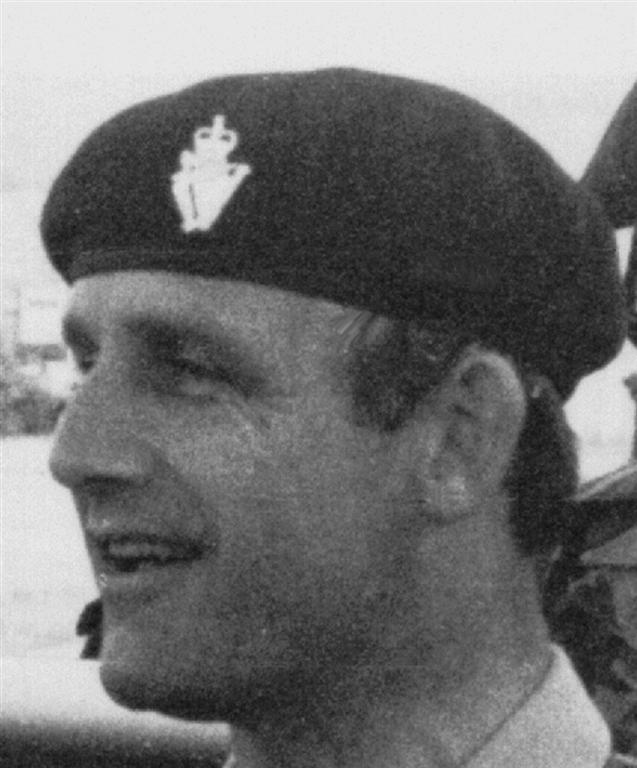
There
are two possible reasons for the limited career prospects of the
local officers. The first could be labelled ‘The Application of
The O’Neill Principle’. Before the Plantation it proved
detrimental for the English to train and promote the native born
Hugh O’Neill to a position where he was able to compromise the
political and operational control of the native militias in 1590.
Second, there were no individuals from Co. Londonderry with the
necessary credentials or commitment to fill the more senior
posts.
Base
Locations
The 5th (Co Londonderry) Battalion of the UDR
had a HQ base in Ebrington Barracks, Londonderry City. The
Battalion was made up eventually of seven companies. Two of the
companies were located in Londonderry city. These were, A Company
on the West Bank, B Company in the Waterside, C Company at
Claudy, D Company at Shackleton Barracks in Ballykelly, E Company
at Laurel Hill House, Coleraine, F Company in Magherafelt and G
Company in Maghera. These companies opened, moved or closed down
on the whim of the ever-evolving recruiting figures and
operational requirements.
From its inception the Regiment
required full-time soldiers for administration duties and to
guard the Battalion and Company HQ bases throughout the day. The
full-time soldiers were called Conrate, referring to the fact
that they were paid consolidated rates of pay, a similar pay
scale used for the Permanent Staff soldiers employed in the TA
Centres (Potter, p39). After 1977 the Conrate were referred to as
Permanent Cadre (PC).
The
part-time element did not operate until after normal industrial
and commercial working hours and the week ends. The UDR, although
part of the Regular Army, was classed as a Home Service Regiment
and all other army units posted over to Northern
Ireland were known as Regular units and
were staffed and manned by Regular officers and soldiers.
Formation
of E Company 5 UDR
Photo 17 Major George Lapsley
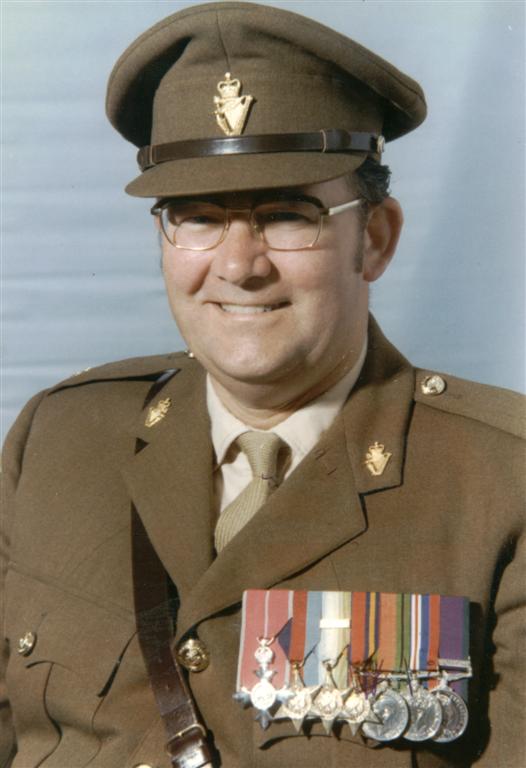
After
the initial recruiting phase George Lapsley was given the task of
forming the company to be based at Coleraine. One of the officers
sent over from England to form the Regiment was Brigadier Logan
Scott – Bowden, Commander UDR. Staff from Headquarters Northern
Ireland (HQNI), Lisburn, conducted the actual vetting and
recruiting. The HQNI staff were responsible for losing many good
recruits particularly in the Coleraine area. Take for example,
the Sub-District Commandant of the Aghadowey B Specials.
Although he was a bit old, he had the command and respect
of all the men in the Aghadowey area. He was informed that he was
too old and would be unable to ‘hack it’. But the recruiter
was talking indirectly to all the B men and they all thought that
if the government didn’t want their Commandant they would not
get any of them.
Another ex-B Special Commandant, Jimmy Simpson, managed to
get into the Company despite his age. That was why Coleraine had
so many B men in the Company in those early years.
Photo18 Jimmy Simpson
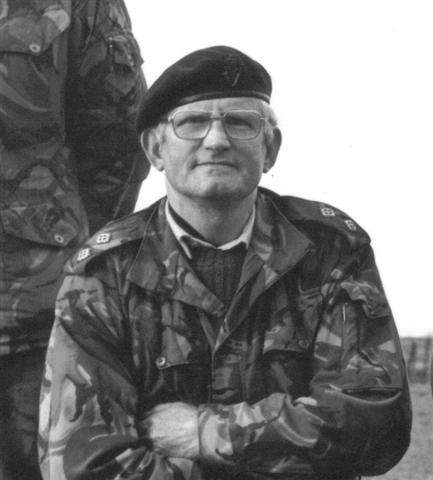
In
the initial stages of forming the Coleraine Company just over
forty men were recruited. One of the first problems facing the
new company was the fact that there was no armoury in Coleraine.
The nearest armoury was located in Ballymoney at the North Irish
Horse base in John Street, which by then had become B Company 1
UDR. Because of this the Coleraine volunteers had to travel to
Ballymoney to report for duty.
The
Part-Time and Full-Time soldiers of E Company were drawn from every
walk of life. They included, architects and accountants, company
directors and plumbers, labourers, bank staff and the occasional
undercover operative from the various intelligence units.
Sometimes bosses as private soldiers were under the command of
their staff who were Corporals or Sergeants. There were
volunteers from both the Roman Catholic community and the
Protestant community, some had King Billy tattoos and others had
Tricolour tattoos. Despite the convolutions in civilian status,
religious conviction, political orientation, ethnic origin and
army rank the company merged into a cohesive working unit and
carried out their duties in an impartial manner.
Company
Structure
Each
company contained a Company HQ with a Major in command and a
staff consisting of a civilian Pay Clerk, an Administration
Warrant Officer (AWO), a Permanent Staff Instructor (PSI, usually
a Colour Sergeant), a Company Sergeant Major (CSM), a Company
Quartermaster Sergeant (CQMS), a Guard Commander (Sergeant) and a
Base Guard of ten soldiers, a civilian storeman and a Motor
Transport Corporal in charge of maintenance.
The main body of soldiers were in the three platoons of 28
men each with an officer (Platoon Commander) and a sergeant
(Platoon Sergeant) in overall command. The platoons were
sub-divided into three sections of at least eight men each with a
Corporal and a Lance Corporal in command. For patrol operations
the sections were split into two teams (or ‘Bricks’) of four.
Women were recruited into the UDR in 1973 and these female
soldiers were usually attached to the platoons or staffed the
company Operations Room.
E Company contained four Part-Time platoons and generally
speaking, each platoon drew its members from specific areas of
Coleraine town as outlined in Table 1.
The majority of 21 Platoon were volunteers from the
Portrush and Portstewart (The Ports) and the Windyhall areas.
Volunteers from the east side of the Bann manned 22 Platoon and
23 Platoon was known as The Heights Platoon. Garvagh and the
surrounding areas was the main source for the platoon located in
Garvagh RUC station, 24 Platoon.
Twenty-three and 24 Platoons were usually tasked to work
together when required and the other two platoons also operated
together when required.
Table
1 Company Structure
|
Regimental
HQ Lisburn |
|||
|
5th
Battalion HQ (Londonderry) |
|||
|
‘E’
Company HQ (Coleraine) |
|||
|
21
Platoon The
Ports |
22
Platoon East
Bann |
23
Platoon West
Bann |
24
Platoon Garvagh |
|
No1
Section No2
Section No3
Section |
No1
Section No2
Section No3
Section |
No1
Section No2
Section No3
Section |
No1
Section No2
Section No3
Section |
Dress
and Equipment
“Everything
seemed strange at the beginning; being sworn in, being issued
with your kit (which usually didn’t fit) and learning what to
do with various items of kit, such as the poncho, puttees and
webbing, not to mention those terrible looking berets! Finally,
being issued with a .303 rifle and ammunition, which you took
home with you when off duty because we didn’t have an armoury
in those days. The rifle, ammunition and the rifle bolts were all
hidden in different places in your home until you were going back
on duty” S Brownlow.
Catering
“When
we reported for duty we travelled with our uniforms and weapons
and usually carried a small pack with a flask of tea or coffee
and sandwiches or bread and jam. Sometimes we shared with men who
had no personal rations with them and sometimes we were lucky to
have rations issued from Battalion Headquarters via the Company
Quartermaster Sergeant (CQMS).
I recall watery stew was often on the menu and by the time
it reached us it was invariably cold but we usually ate it along
with dry bread. This was followed by rice pudding and jam washed
down with a mug of sweet tea. Conditions were primitive in the
extreme during the first couple of years but improved greatly in
later years as the standards rose.
It was always very good to go on joint operations with the
troops stationed at Kilrea or Londonderry as not only did we
contribute to the tasks but also we enjoyed ‘egg banjos’ and
other tasty snacks after patrols” (Hamill, 2007).
Ballymoney
Company Transfers
“I
was one of the 50 or so men who transferred from B Company of the
1st (Co Antrim) Battalion based in Ballymoney to the 5th
(Co Londonderry) Battalion in late 1970. The aim was to form a
new Company based initially at Macosquin, a few miles outside
Coleraine. As we had already been deployed on operations in
County Antrim and Belfast, we were keen to get on with the tasks
in our new operational area, which included Londonderry City and
County.
This was an important change, as we believed the
Londonderry border with County Donegal in the Republic of Ireland
would become part of our new territory and so it was to be.
We
also wanted to get to know our new Battalion, which had its
Headquarters in Londonderry at the former naval base, HMS Sea
Eagle at Ebrington Barracks (1840)” (Hamill, 2007).
The
Macosquin Base
“Eventually
common sense prevailed and in 1971 the Company was relocated at
the former B Specials’ Drill Hall of the Englishtown Platoon in
Macosquin. This had been purpose built in 1966/67. It had a
reinforced roof and there was a .22 range at one end of the hall.
It was very bare and spartan and totally different from
the facilities and organisation we had become familiar with in
Ballymoney. There were no offices, stores, armoury, sangars or
guardroom, just a few chairs in an empty building with a
five-barred gate outside at the entrance, and so we quickly got
on with the job of making this building our new Company
Headquarters.
This was pioneering soldiering at its best and we all felt
determined to work well with our new Company Commander, Major
George Lapsley who quickly recognised our strengths and
weaknesses, the old and bold, and the experienced, dedicated
soldiers who were keen to make their mark.
Initially, I suspect the locals in Macosquin were somewhat
intrigued and bemused at the Army’s comings and goings in their
sleepy village community but soon accepted our presence. It was
to become a very busy place as the pace of our operations
increased and various essential improvement works were carried
out. Before long we had a suite of Portacabins for offices and
the base became more military like and fit for purpose”(Hamill,
2007).
Company
Duties
The
duties and operational tasking were planned at Battalion HQ.
After that the OC E Company was expected to task his men to cover
these duties. A couple of weeks before the start of a new month
he would sit down in front of his table and read out the duties
to the four platoon sergeants. They had the loyalty of the men in
their platoons. The OC would say, “Red 2, next Monday night”.
That was a duty requiring twelve men. One of the Platoon
Commanders would put their hand up. Next the OC would call out
for the Power station, the Telephone exchange and other places
that were under threat. Hands would go up for each duty. Then the
Platoon Sergeants would go and detail off the men to cover that
particular duty.
Eventually the Company strength was large enough to parade
a Company Headquarters, four full platoons and a Base Guard. At
that stage a coded duty sheet was issued to every man in the
Company so that they knew when to parade for duty. The company
was able to carry out duties on every night of the week as well
as the weekends.
“The
first operational tasks we had at Macosquin were foot patrols in
the Macosquin area. We had no transport to move us around so we
carried out Lurk patrols. That was a tactic where we would go out
on foot patrol and stay hidden in the hedgerow, stopping the
occasional car, just as we had done in the ‘B’ Specials. Many
months later we did get our own vehicles. Prior to that we had to
borrow our transport from other army units when we wanted to
expand our patrol base. Usually we managed to borrow two soft-top
Landrovers and a 4-ton truck. Thanks to the generosity of all the
local Army units.” S11.
“The
company was also responsible for guarding the Bushtown
electricity sub-station and other static key installations in the
immediate area. After Bloody Sunday when the terrorism escalated
we also went on to guard RUC stations, including Kilrea RUC
station. In later years we carried out guard duties at places
further afield including Coolkeeragh power station near
Londonderry city” S11.
Pay
Days
The
Company was at Macosquin for one year before moving to Laurel
Hill House in Coleraine. On one occasion at Macosquin the Army
had run out of ready cash and was unable to send us our weekly
pay. George Lapsley went and explained the problem to a local
businessman. The man trusted George implicitly and allowed him to
draw £400 from his safe. The next day the Commanding Officer of
the Battalion went out of his way to visit the businessman and
thank him because he could not believe that he had allowed George
to go into his safe and help himself.
The
Company Sergeant-Major
While
the Company was at Macosquin it was growing in strength and
needed a good Company Sergeant Major (CSM). A Company can’t
function efficiently without the guiding hand of an experienced
CSM.
Photo 19 Sergeant Major John Kerr MBE MM
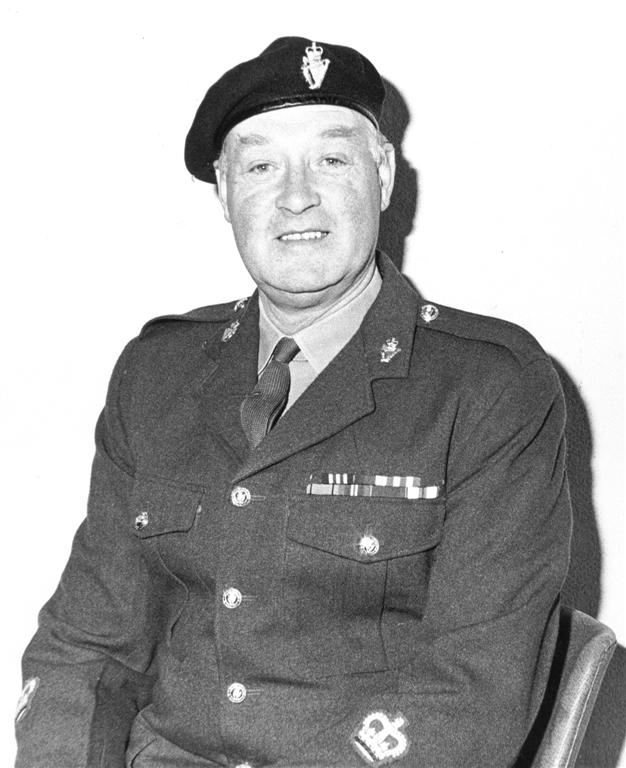
Sergeant
Major John Kerr MBE MM
The
OC first met John when he went to Garvagh to seek his help in
forming the new E Company. He had heard from various sources
about John’s military career and other work John had done in
the past. After talking to him for a couple of minutes the
Officer Commanding knew that he was the man for that challenging
task. John Kerr was one of the finest men you would ever meet. He
had a presence and men under his gaze knew to obey instantly. But
in their hearts they all knew they had a dependable friend as
well.
At that time John worked for TBF Thompson in Garvagh. When
TBF learned that John was about to depart he immediately offered
him an inducement of £20 a week.
That was a very substantial pay rise in the early 1970s.
But John had given his word and, in truth, he was looking forward
to a return to army life.
In the Sergeant’s mess men would listen enthralled as he
talked about his experiences on the Anzio landings in 1944. On
one occasion he was nearly shot by the German officer who
captured him. John rebuked a young sergeant for expressing a
‘Gung Ho’ attitude towards dealing with terrorists. John
looked the unfortunate Sergeant in the eyes and asked, “Have
you ever killed anyone? It’s not a nice experience you know”.
He continued, “One particular day at Anzio I was bayonet
charging across a farm yard and the Germans counter charged us. I
pulled the trigger on my rifle and a young German soldier fell to
his knees in front of me. He was about the same age as me, 18
years old. He looked at me and he knew he was dying. I knew he
was dying. I ran on and we won that day”.
That story appears in Fitzgerald’s (1949) ‘History of
the Irish Guards in the Second World War’. The book outlines
the last battle of the 1st Battalion Irish Guards at
Carroceto on 6 Feb 1944. Page 308 describes why John was awarded
the Military Medal:
“Guardsman
English, a Bren gunner and Guardsman Kerr, like terriers after
rats, shot and bayoneted their way through every stable and up
into the lofts”.
What
this version failed to convey was the haunted look on John
Kerr’s face as he told his story to a very chastened young
Sergeant.
Many of the senior officers who visited Laurel Hill were
surprised to meet the man who had trained them years before at
the Officer Training School, Warminster.
John
only had one week’s holiday a year; he always went to Annual
camp. That was the time when John and his Merry Band: Albert,
Hugh and Kitty would enjoy life in relative safety, sometimes
commandeering the Company Commander’s vehicle as their taxi.
His ashes now rest in Coleraine Cemetery and you can be sure he
often looks across the river Bann towards Laurel Hill.
Photo
20 Albert McAfee
Photo 21 Hugh
McQuilken
Photo 22 Kitty McConachy
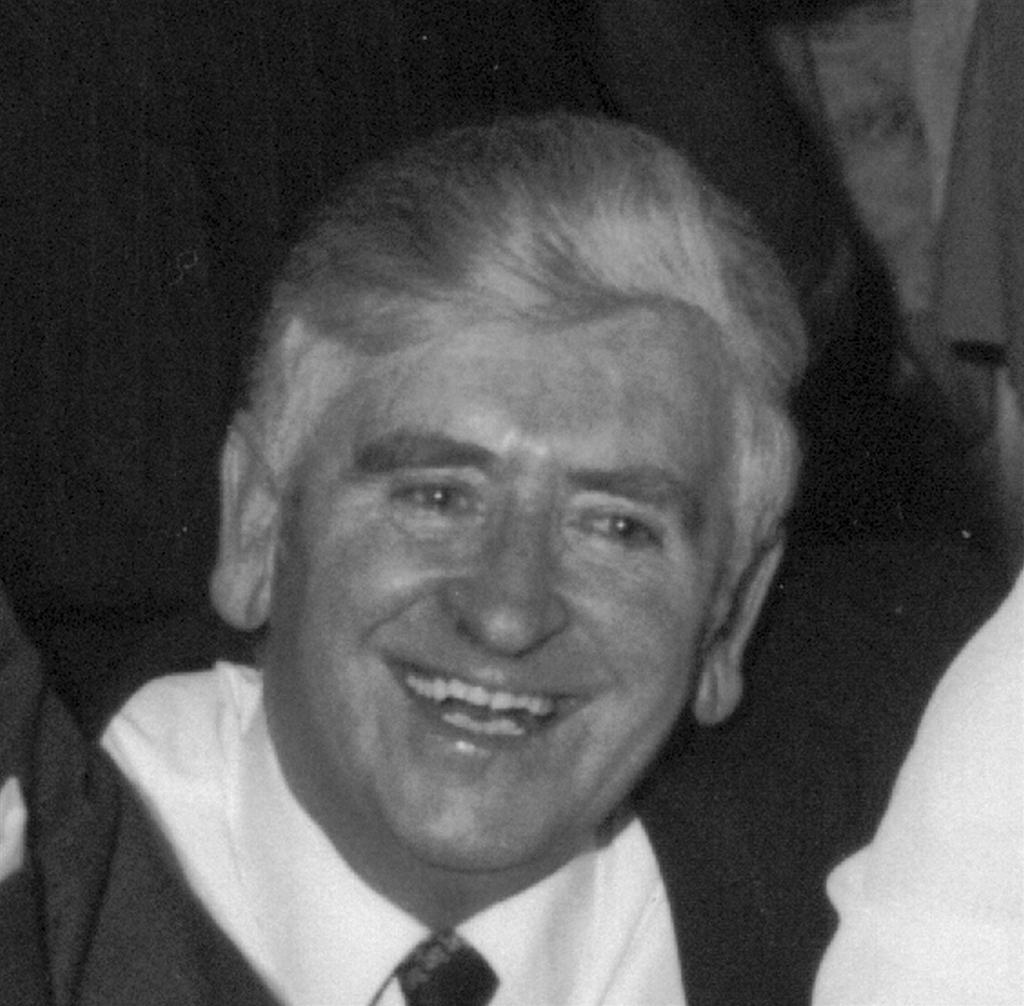


Laurel
Hill House
It
was not until 1972 that the Coleraine Company was based in
Coleraine town. Up until that time George Lapsley was second in
command of the 5th Battalion (Co. Londonderry) UDR. He
requested and was granted the post of Company Commander E Company
(Coleraine) and was then addressed as the OC E Company.
As the OC E Company George Lapsley was not happy with the
former USC Drill Hall in Macosquin. He spent a lot of his limited
time travelling around the Coleraine area looking for a suitable
base location for his Company. He eventually met Mr Noel Henry
who bewailed the fact that his planning permission to use Laurel
Hill House as a hotel had been turned down. The agreed price
between George and Noel was £24,000.

Laurel Hill House
The Army Property Services department were suspicious as
to how George could get the property for such a low price. They
did not have to wait long to find out. Because of a combination
of wet and dry rot it took over £100,000 to repair the house and
then more to convert it for the Company’s use.
Laurel Hill House is located on the high ground to the
west of the town. It overlooks the River Bann and was an imposing
gentleman’s residence with extensive grounds. The Kyle family
inhabited the house since 1711; hence the road outside the estate
was named Kyle’s Brae. The last Kyle to own it was Henry, the
son of Rev Arthur Kyle, the minister of First Coleraine
Presbyterian Church from 1761 to 1808. Henry died in 1878.
During WW2 Laurel Hill House accommodated elements of the
American army. Recent renovations unearthed a detailed map of
Europe on the wall of the former Sergeants’ Mess. This drawing
outlined the progress of the Allied Forces in Europe during WWII.
The map has been carefully preserved.
The
Pink Lady
The
house was supposed to be haunted by the ghost of the ‘Pink
Lady’ and several brave souls swore they saw her in the early
morning hours. But that was usually after some social occasion.
On one occasion the company mascot, a Great Dane called Swain,
was taken into the house but as soon as it reached the bottom of
the stairs, its hackles went up and it refused to climb the
stairs. That story only embellished the legend. There were some
soldiers on guard duty from time to time that refused to enter
the house after midnight!
The
Renovations
The
house and grounds required much renovation to convert to a Rifle
Company base and during the initial months while the necessary
work was underway the company had to make do with quite a few
hardships in accommodation and facilities but it was much better
than Macosquin.
The accommodation was not custom built but it was made
very accommodating and comfortable. In the outbuildings the Round
Tower became the Guard Room and Armoury while the adjacent shed
and yard space was ideal for the Motor Transport (MT) Section
where the MT Lance Corporal soon established his workshop and
office. The cow byres beside the MT were cleared out and
transformed into a 25-metre mini-range.
Photo 23 The Guard Room
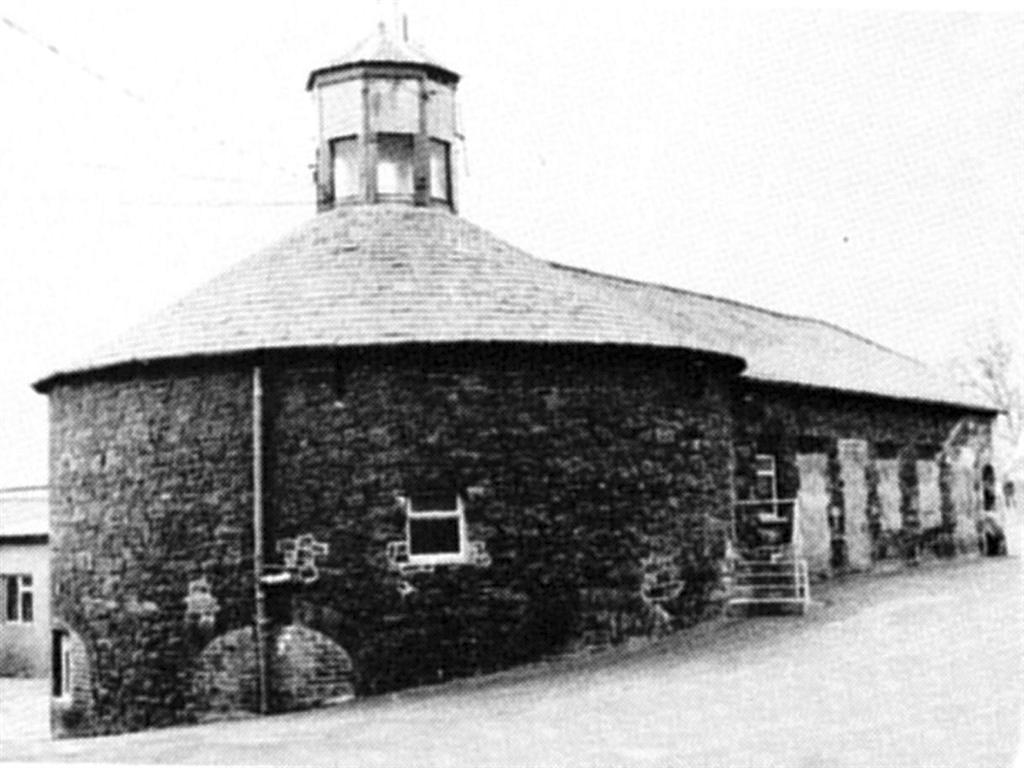
In the main house the first floor contained the Warrant
Officers and Sergeant’s Mess, a lecture room, the Company
Sergeant Major’s office, Company stores and the Training office
for the Permanent Staff Instructors.
Upstairs there was space for the Junior Ranks’ Bar and
the Officers’ Mess and the Pay Clerks office while the Company
Commander’s office looked out over Sandleford Bridge. The
original Company Operations Room was also on the first floor.
Various other improvements were carried out on a number of
occasions to improve the gate sangars and perimeter fence
including building a Pipe Range where the tennis court had once
been. A snooker room was established below the Guardroom and this
was put to good use on many occasions.
“The
Junior Ranks Bar was open about three nights every week and after
a training day. It was a great place to relax and have a drink
without having to worry about your personal security. Unlike
public bars, there was discipline built in and no fights or
serious confrontations ever took place.
To liven the nights up our platoon commander organised a
live band. There was Jimmy McCluney on the accordion and Scrapper
O’Neill on the drums along with the four of us who were in a
local band. The craic was always good, particularly on a
Thursday night. That was the Company night when the whole of the
administration block was open for training, stores issues and
exchanges, administration and discipline. After the
administration was sorted everyone retired to the bar and
relaxed” S20.
“The
rule was that if your platoon was on duty that night, the duty
platoon was denied use of the bar facilities. The platoon duty
came first. On one memorable night a particular sergeant took it
upon himself to relax in the Sergeants Mess as opposed to
patrolling with his platoon. I took over the OC’s office and
had the offending Sergeant marched in. I gave him a severe
‘talking to’ and reminded him about the basic ground rule and
not to repeat his indiscretion. I carried on and completed my
paperwork before proceeding to Ballykelly to take command of my
platoon from the Battalion Operations Room. There was a knock on
the office door and in popped the Sergeant’s wife. She was in
tears and complained about the way I had spoken to her poor
husband for not reporting for duty” (H Jamieson, 2007).
“A
helipad was built within the grounds and before long helicopters
were landing and taking off much to the delight and surprise of
the neighbouring residents and their children who peered through
the fence in amazement. Eventually a drill hall was built beside
the helipad. The drill hall was fitted with a bar facility and on
many occasions each platoon held their own social functions
there, including children’s Christmas parties.
All in all the company now had a Headquarters, which had
character, and purpose and everyone was very proud of the
facilities at Laurel Hill House” (Hamill, 2007).
The Company Sergeant Major
When
the company became established in Coleraine town, WO2 J Kerr MBE
MM was appointed Administration Warrant Officer (AWO) of the
Company and the duty of Company Sergeant Major (CSM) passed on to
a series of part time SNCOs including the late Roy Marshall. He
had served in the Enniskilling Fusiliers from his teenage years
and had seen much action around the world, including Kenya,
Cyprus, and Kuwait.
Photo 24 CSM Roy Marshall
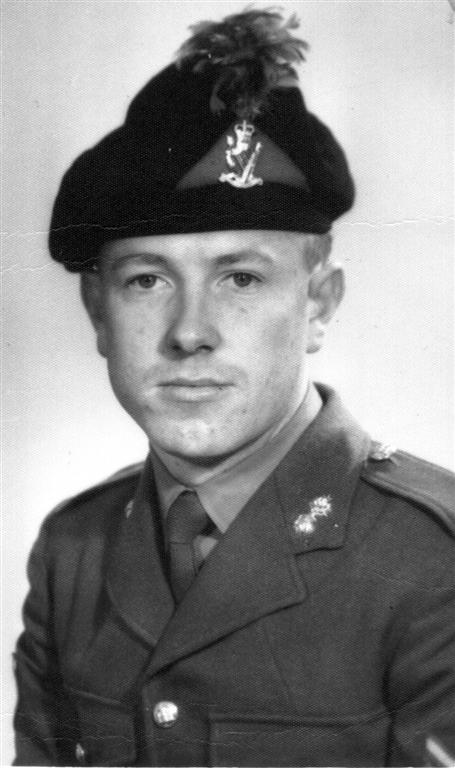
The
Base Guard
Once
the company was located at Laurel Hill House, a Base Guard had to
be established. The Full-Time soldiers employed on the base guard
at Coleraine were still referred to as Conrate. The two Base
Guard sections worked on a weekly rota. One week they would cover
three, sixteen-hour shifts and the following week they would
cover four, twelve-hour shifts. Full-Time soldiers through the
day did this from 4am until 8pm.
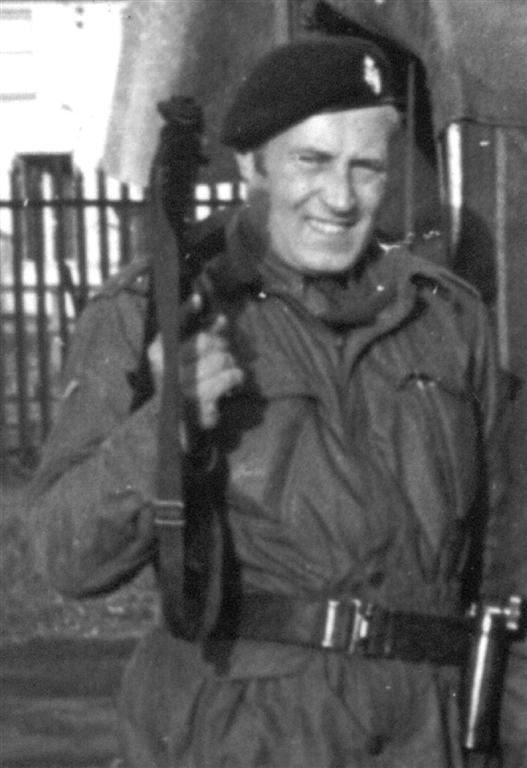
Guard Commander-Sgt Gordon Taylor
The Part-Time soldiers covered the Base Guard at night and
some of the weekend duties. The Full-Time soldiers usually worked
a forty-eight-hour week. The Full-Time soldier’s pay was very
poor at this time and the rota gave them the opportunity to earn
money in civilian work.
Later on in the 80s the Part-Time soldiers were allowed to
do the base guard at Coleraine. This allowed the Permanent Cadre
soldiers to go on leave or courses.
Building new gate sangars became the subject of much
debate. Many ‘expert’ opinions were presented and dismissed
but it was usually the Royal Engineers who had the last say.
One day the Guard Commander was tasked to cut down one of
the trees in the yard. The tree was hollow but it came down
without any problems. The next task for the Guard Commander that
day was to collect all the confidential documents and incinerate
them. We did not have a proper incinerator at that time so the
Corporal decided to use the hollow tree as an incinerator.
He piled in all the documents and sprinkled the pile with
a bottle of petrol from one of the Landrovers. Then he asked me
for a box of matches to light the papers. It was a windy day and
he had a bit of trouble starting the fire. He then went into the
hollow and tried again despite all my warnings.
The
petrol fumes went off with ‘whoosh’, his beret came flying
through the air and then the Corporal emerged from the tree
hollow with his face burnt red, his glasses and eyebrows gone.
E
Company Strength
“Within
six months the 40 Volunteers from the Ballymoney camp became 100
men then 200 and then 289 men and 9 officers by the time I
retired.
Females
(Greenfinches) were then recruited into the UDR in 1973. They did
an excellent job alongside the men out on patrol and in the
bases.
We had one of the best companies in the whole of the UDR
– it was showcased and we won many competitions and were
visited by many VIPs. There has always been a great notion of
service and volunteer spirit in Coleraine. There were many Royal
Air Force, Royal Navy, Army and ex-B Specials and there was great
respect for all these men – they were looked up to” (Hamill,
2007).
“Our
operational capability progressed and increased as the terrorist
threat grew. It was quite normal for most part-time soldiers to
carry out a minimum of three operational duties per week with
training fitted in at weekends. Much emphasis was placed on
weapon training and shooting and we spent many training days and
nights at Magilligan, Portballintrae and Eglinton ranges.
Other infantry skills for counter terrorist operations
were practised too and we took it all in our stride as we knew
the situation in the Province was deteriorating fast. The
atmosphere was terribly exciting and demanding – there was a
camaraderie that I had never experienced; the comradeship was
infectious.
There was a real “can do” attitude and a determination
to make the Regiment, the Battalion and the Company a success.
There was strong motivation to raise the professional standard
and to do the best we could. Men volunteered readily for all
operational tasks and there was never a problem in filling the
duty roster. Platoon Commanders organised and practised call-out
procedures. Section Commanders and Platoon Non-Commissioned
Officers became more responsible for commanding guards and
patrols and it was very satisfying to see the command structure
working as the Company continued to grow in strength and
capability”(Hamill, 2007).
Frank
Pancott
“Frank
Pancott was quite a character. He had served in the regular army
in WW2 with quite a distinguished career. He had been a Permanent
Staff Instructor with the B Specials and eventually found himself
in the post as store man to E Company 5 UDR. In the course of his
duties as store man he had to attend conferences with the
Quartermaster (QM) of 5 UDR.
At one of these conferences there was a long and heated
discussion about losses. Frank never had any losses; in fact I
thought Frank had surpluses. No losses were ever recorded while
Frank maintained the stores at E Company ‘and my lips are
sealed’.
As well as the store men attending this conference there
were other QMs from other units. One QM had lost a Parka Jacket.
These were valuable ‘starred items’ and had to be accounted
for throughout their service. It was frowned upon if you ever
lost one of these items. On this occasion the QM was being told
off for incurring the loss. Another QM thought this was hilarious
and started laughing. The Commanding Officer turned to him and
said, “What are you laughing at? I will be with you in a minute
because I want to know what happened to the boat which appears to
have gone missing from your account” S4.
Previous Chapter 6 - The First Officer Commanding E Company Next Chapter 8 - E Company - The Early Years - The 70s